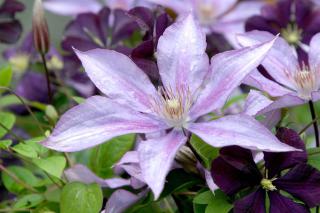

Clematis is a vining, climbing flower which is beautiful thanks to its blooming.
Key Clematis facts
Name – Clematis
Family – Ranunculaceae
Type – vine
Height – 6 to 40 feet (2 to 12 meters)
Exposure – full sun
Soil – deep and cool
Foliage: deciduous or evergreen – Flowering: March to October
The planting, pruning and caring for clematis are as many small things to do that will considerably increase the blooming.
The planting of clematis is either done in fall or spring, as long as it doesn’t freeze, in a blend of garden soil and soil mix.
Something really important is that the base of the plant must stay in the shade. Plant other flowers around the base to cover it and keep it cool.
If the base is in direct sun, (ie., sunlight hits the root collar), then cover it with an old tile or a few odd rocks.
 Plant the foot of the plant about 8 to 12 inches (20 to 30 cm) from the lattice or structure you expect it to climb along.
Plant the foot of the plant about 8 to 12 inches (20 to 30 cm) from the lattice or structure you expect it to climb along.
Practically, certain varieties like Clematis alpina are better suited to it because of their slow growth.
Clematis is quite uncomplicated, and can be done in various manners like cuttings, layering or grafting.
Generally, clematis vines are very hardy, especially at root level. They’re well-suited to most temperate climates, since they grow back from the stump even if airborne parts were frozen stiff.
This vine isn’t difficult to care for, and as years come and go, care just gets easier and easier. A little water and fertilizer (optional) will boost growth and blooming.

Also important is to water in case of dry weather because moist and cool soil is what clematis prefers.
Pruning is a requirement to boost blooming and branching out.

For small-flowered clematis (spring blooming), prune in summer after the flowers have wilted away, eliminating dead wood and stems that are gobbling up too much space. Also cut back older stems by ⅓.

Pretty hardy, clematis will resist cold and freezing down to the vicinity of 14°F (-10°C).
The diversity you’ll encounter when looking up available varieties will stun you. There’s a wide range of colors and shapes, and also 2 distinct blooming seasons: one in spring and the other in summer. Some species even bloom in winter, like Clematis cirrhosa.
Clematis offers a wide scope of sizes, the smallest maxing out at 8 feet (2.5 m) tall, and others climbing up to over 32 feet (10 meters).
There are also clematis that have large or small flowers, too. In the end, ’tis like having to choose from a kaleidoscope of varieties, each as appealing as the next.
Clematis are decidedly deserving of their nickname: Queen of vines.
From the list of interesting species and cultivars, take note of Clematis armandii, Clematis alpina and Clematis montana.
You can attach your clematis to a lattice to ensure it develops the way you want it to!